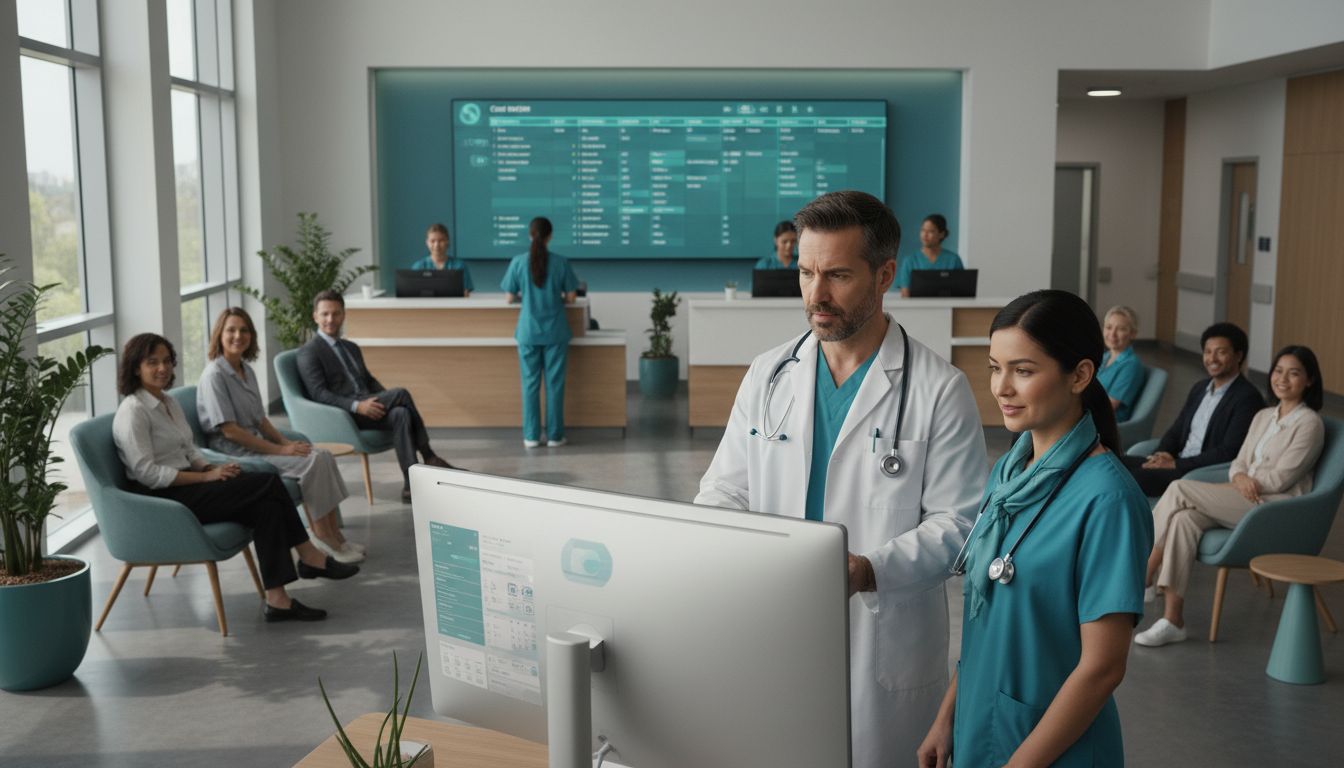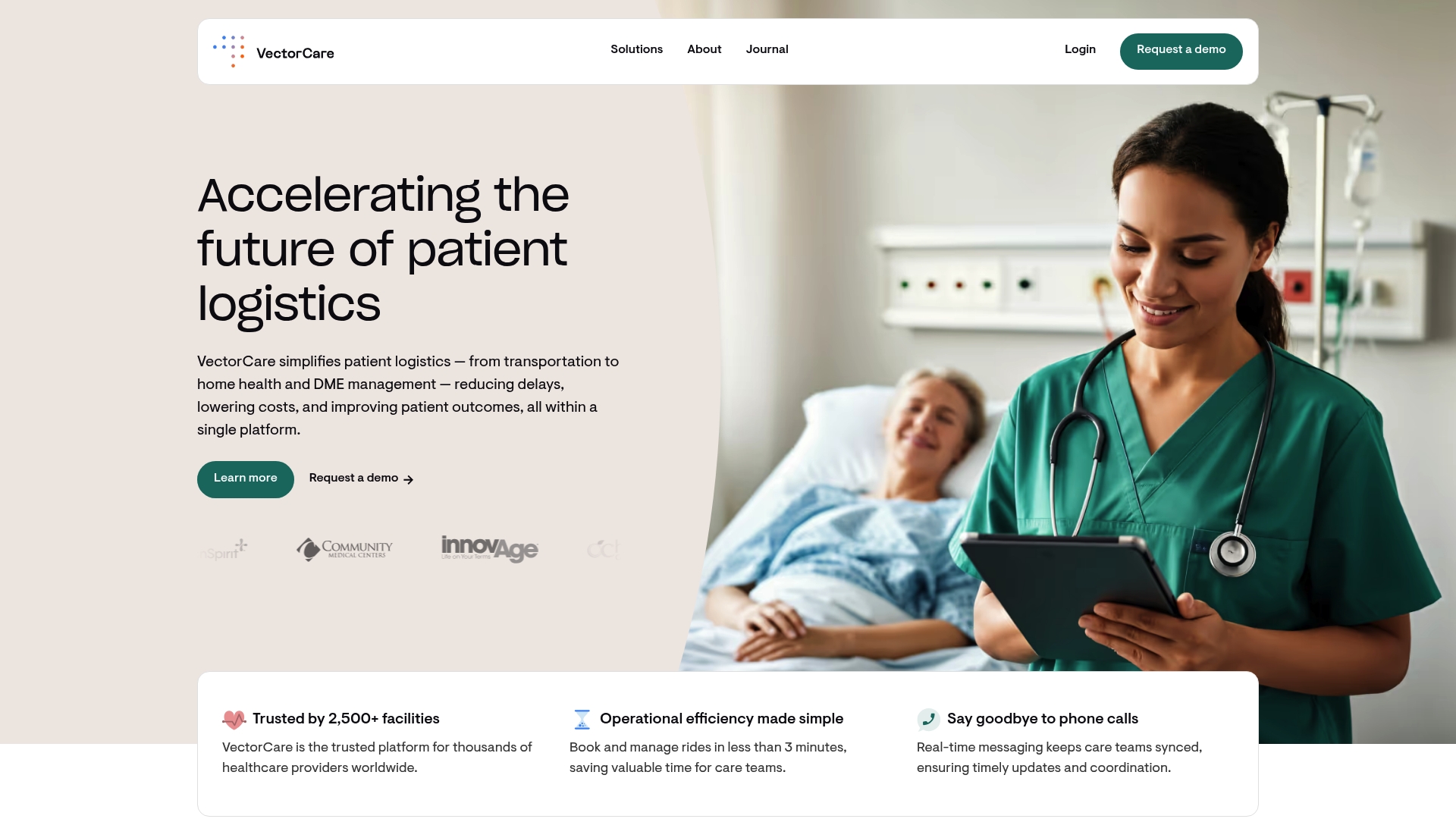7 Best Healthcare Scheduling Software for Smooth Operations

Did you know that nearly 30 percent of patients have missed appointments because of complicated scheduling systems? Poor coordination hurts care quality and disrupts daily operations. Healthcare organizations face mounting pressure to create smoother workflows and improve patient access. Streamlined scheduling, automated dispatch, and secure communication tools can make a real difference in how care teams function and how patients experience their treatment.
Table of Contents
- 1. Streamlining Appointment Scheduling For Care Teams
- 2. Automating Dispatch For Emergency And Non-Emergency Services
- 3. Integrating Vendor And Resource Management Features
- 4. Ensuring HIPAA Compliance And Data Security
- 5. Leveraging Real-Time Updates And Communication Tools
- 6. Utilizing AI-Driven Scheduling Optimization
- 7. Scalability And Customization For Different Health Sectors
Quick Summary
| Takeaway | Explanation |
|---|---|
| 1. Prioritize patient-centered scheduling | Focus on accommodating patient preferences and urgent needs to reduce wait times and improve satisfaction. |
| 2. Implement automated dispatch systems | Utilize AI-powered dispatch to enhance operational efficiency, reduce errors, and ensure faster emergency responses. |
| 3. Invest in robust vendor management software | Create effective partnerships through centralized tracking and integration to optimize resources and services. |
| 4. Enhance data security compliance | Adopt comprehensive security measures and training to protect patient information and maintain HIPAA compliance. |
| 5. Enable real-time communication tools | Implement advanced communication systems to ensure seamless information exchange, improving team coordination and patient care. |
1. Streamlining Appointment Scheduling for Care Teams
Healthcare scheduling goes far beyond simply placing appointments on a calendar. Effective scheduling is a strategic approach that dramatically impacts patient care, resource management, and overall operational efficiency.
According to research from the Agency for Healthcare Research and Quality, open access scheduling represents a transformative strategy for modern healthcare providers. This approach allows patients to secure same-day appointments, which directly reduces wait times and significantly improves patient satisfaction. By analyzing patient demand patterns and addressing existing appointment backlogs, care teams can create more responsive and patient centered scheduling systems.
The key to successful scheduling lies in prioritizing patient needs over administrative convenience. Traditional scheduling models often create barriers that limit patient access. A more dynamic approach considers multiple factors:
- Patient preferred time slots
- Provider availability
- Urgent care requirements
- Comprehensive time management
Implementing intelligent scheduling software can help healthcare organizations optimize these complex interactions. Learn more about technology enhancing patient appointment logistics to understand how digital solutions are revolutionizing healthcare access.
Practical implementation requires a multifaceted approach. Care teams should conduct regular audits of their current scheduling processes, identify bottlenecks, and leverage technology that offers real time adaptability. By treating scheduling as a strategic function rather than a mechanical task, healthcare providers can create more efficient patient journeys and improve overall operational performance.
2. Automating Dispatch for Emergency and Non-Emergency Services
Dispatch automation represents a critical technological leap in healthcare transportation and emergency response systems. By integrating advanced software solutions, organizations can transform how medical resources are allocated and managed in high-pressure scenarios.
According to research from the Department of Homeland Security, artificial intelligence is revolutionizing emergency medical service call centers. AI-enhanced dispatching platforms support first responders by creating more efficient triaging processes during medical emergencies. This technological intervention addresses multiple critical challenges in healthcare logistics.
The core benefits of automated dispatch systems include:
- Faster response times
- Reduced human error
- More precise resource allocation
- Enhanced patient tracking
- Real time communication capabilities
Modern dispatch automation goes beyond simple routing. Learn how fire and EMS departments are improving response and patient transfers through intelligent software solutions. Artificial intelligence is particularly transformative in addressing systemic challenges like staffing shortages and operational inefficiencies.
Healthcare organizations can implement dispatch automation by selecting platforms with robust integration capabilities, comprehensive reporting features, and intuitive user interfaces. The goal is creating a seamless ecosystem where technology augments human decision making rather than replacing critical human judgment. By embracing these innovative tools, emergency and non emergency service providers can dramatically improve patient outcomes and operational effectiveness.
3. Integrating Vendor and Resource Management Features
Vendor and resource management represents a critical strategic function for healthcare organizations seeking operational excellence. Modern healthcare systems require sophisticated approaches to tracking, coordinating, and optimizing external service providers and internal resources.
Successful integration goes beyond simple tracking. It involves creating a comprehensive ecosystem where vendors are not just managed but strategically aligned with organizational goals. This approach transforms vendor relationships from transactional interactions into collaborative partnerships that drive healthcare delivery efficiency.
Key components of effective vendor and resource management include:
- Centralized vendor performance tracking
- Real time resource availability monitoring
- Automated compliance verification systems
- Dynamic credentialing processes
- Transparent communication channels
Understanding the complexities of healthcare vendor management helps organizations develop more resilient and adaptable service networks. Healthcare providers must view vendor management as a dynamic strategic function rather than a static administrative task.
Implementation requires investing in robust software platforms that offer comprehensive visibility, integration capabilities, and advanced analytics. The goal is creating a seamless system that reduces administrative overhead, minimizes risk, and ensures consistent high quality service delivery across all vendor and resource interactions. By treating vendor management as a strategic priority, healthcare organizations can unlock significant operational efficiencies and improve overall patient care outcomes.
4. Ensuring HIPAA Compliance and Data Security
Healthcare data security represents a critical shield protecting patient information in an increasingly digital medical landscape. With sensitive medical records becoming more digitally integrated, robust compliance mechanisms have transformed from optional considerations to absolute necessities.
According to the U.S. Department of Health and Human Services, the HIPAA Security Rule provides comprehensive guidelines for safeguarding electronic protected health information. This framework establishes fundamental standards that healthcare organizations must implement to maintain patient data integrity and confidentiality.
Key strategies for maintaining comprehensive data security include:
- Implementing multi factor authentication
- Encrypting patient data transmission
- Conducting regular security audits
- Training staff on privacy protocols
- Creating comprehensive incident response plans
Understanding data privacy practices in healthcare helps organizations develop more robust protective strategies. Modern healthcare software must go beyond basic compliance to create comprehensive security ecosystems that anticipate and mitigate potential vulnerabilities.
Successful implementation requires a holistic approach that combines technological solutions with human awareness. Healthcare providers must invest in advanced security platforms that offer real time monitoring, automated threat detection, and seamless integration with existing medical record systems. By treating data security as a dynamic ongoing process rather than a static checklist, organizations can protect patient information while maintaining the operational flexibility needed in modern healthcare environments.
5. Leveraging Real-Time Updates and Communication Tools
Real-time communication represents the critical nervous system of modern healthcare operations, enabling instantaneous information exchange that can literally save lives. By integrating advanced communication technologies, healthcare organizations transform fragmented communication channels into seamless collaborative networks.
Research from the Department of Homeland Security highlights how AI-facilitated communication systems are revolutionizing emergency medical services. These sophisticated platforms provide first responders with immediate access to critical information, reducing response times and improving patient outcomes.
Key features of effective real-time communication tools include:
- Instant messaging capabilities
- Geolocation tracking
- Secure patient information sharing
- Automated status updates
- Cross platform compatibility
Discover strategies for improving team collaboration in healthcare settings to understand the transformative potential of modern communication technologies. Successful implementation requires more than just technological solutions it demands a cultural shift toward transparent and immediate information sharing.
Healthcare providers must view communication tools as strategic assets that enhance operational efficiency and patient care. By selecting platforms that offer robust security, seamless integration, and user friendly interfaces, organizations can create communication ecosystems that respond dynamically to complex medical challenges. The ultimate goal is creating an environment where critical information flows effortlessly, enabling faster decisions and more coordinated patient care.
6. Utilizing AI-Driven Scheduling Optimization
Artificial intelligence represents a transformative force in healthcare scheduling, turning complex logistical challenges into streamlined operational opportunities. By leveraging advanced machine learning algorithms, healthcare organizations can dramatically improve resource allocation and patient care efficiency.
Research from the International City/County Management Association demonstrates how AI is revolutionizing emergency services by addressing critical staffing and scheduling complexities. These intelligent systems go beyond simple calendar management to create dynamic scheduling ecosystems that adapt in real time.
Key capabilities of AI powered scheduling optimization include:
- Predictive patient demand forecasting
- Intelligent resource allocation
- Automated shift management
- Personalized scheduling recommendations
- Conflict resolution algorithms
Explore essential tips for online scheduling in healthcare to understand the foundational principles driving these technological advancements. Successful implementation requires more than technological investment it demands a strategic approach that balances human expertise with machine intelligence.
Healthcare providers must view AI scheduling tools as collaborative partners that augment human decision making. By selecting platforms with robust machine learning capabilities, transparent algorithms, and intuitive interfaces, organizations can create scheduling systems that reduce administrative burden, minimize human error, and ultimately improve patient access to care. The future of healthcare scheduling is not about replacing human judgment but empowering professionals with intelligent, adaptive tools.
7. Scalability and Customization for Different Health Sectors
Healthcare technology solutions must adapt as dynamically as the diverse medical ecosystems they serve. No single scheduling approach works universally across emergency services, home health agencies, private practices, and large hospital networks.
Research from the Agency for Healthcare Research and Quality emphasizes the importance of flexible scheduling models that can analyze patient demand and address unique organizational requirements. Successful platforms must offer configurable workflows that accommodate the distinctive needs of various healthcare environments.
Key considerations for scalable healthcare scheduling platforms include:
- Modular design architecture
- Configurable user permissions
- Specialized workflow templates
- Integration with sector specific electronic health records
- Adaptive reporting capabilities
Explore patient logistics solutions for public health agencies to understand how technology can transform operational capabilities across different healthcare contexts. The most effective scheduling software acts as a responsive framework that can expand or contract based on organizational complexity.
Healthcare providers should prioritize solutions offering granular customization options. Whether supporting a small rural clinic or a metropolitan hospital system, the right scheduling platform should feel like a tailored solution rather than a generic tool. The ultimate goal is creating a technological ecosystem that enhances operational efficiency while maintaining the unique character of each healthcare organization.
Below is a comprehensive table summarizing the strategies and solutions in healthcare operations discussed throughout the article.
| Topic | Description | Key Strategies |
|---|---|---|
| Streamlining Appointment Scheduling | Effective scheduling improves patient care and operational efficiency. | Use open access scheduling, prioritize patient needs, and implement intelligent scheduling software. |
| Automating Dispatch | AI enhances dispatch efficiency for emergency services. | Implement AI platforms for triaging, real-time communication, and precise resource allocation. |
| Vendor and Resource Management | Transforms vendor relationships into strategic partnerships. | Use centralized tracking, automated compliance, and dynamic credentialing. |
| HIPAA Compliance & Data Security | Essential for protecting patient data. | Implement multi-factor authentication, data encryption, and regular security audits. |
| Real-Time Communication | Enhances operational efficiency and patient care. | Employ instant messaging, geolocation tracking, and automated updates. |
| AI-Driven Scheduling Optimization | Improves resource allocation and scheduling efficiency. | Utilize predictive forecasting, intelligent resource allocation, and conflict resolution algorithms. |
| Scalability and Customization | Adapts to diverse healthcare environments. | Integrate modular design and specialized workflows adaptable to different sectors. |
Transform Your Healthcare Scheduling with VectorCare
Struggling to manage complex patient appointments, real-time dispatch, and vendor coordination as highlighted in the article on the best healthcare scheduling software The key pain points include reducing delays, optimizing resource allocation, and ensuring HIPAA compliance VectorCare addresses exactly these challenges with an integrated platform that unites scheduling optimization, AI-driven dispatching, and secure communication to streamline operations and improve patient outcomes

Take the next step toward smoother healthcare operations by exploring how VectorCare’s digital solutions empower providers, emergency services, and health agencies to reduce administrative burden and increase efficiency Discover more about these transformative tools at VectorCare’s website and see how intelligent scheduling software can revolutionize your patient logistics from appointment booking to vendor management Visit VectorCare’s homepage to get started today and unlock the full potential of coordinated care
Frequently Asked Questions
How can healthcare scheduling software improve patient access to care?
Effective healthcare scheduling software allows for dynamic appointment management, which can significantly reduce wait times for patients. By implementing software that adapts to patient demand and preferences, organizations can increase same-day appointment availability and enhance overall satisfaction.
What features should I look for in healthcare scheduling software?
Key features to consider include real-time availability monitoring, automated appointment reminders, and customizable workflows tailored to different healthcare settings. Select software that offers integration with electronic health records to streamline data management and improve operational efficiency.
How does AI-driven scheduling optimization enhance operational efficiency?
AI-driven scheduling optimization uses machine learning algorithms to predict patient demand and automate shift management. By leveraging these capabilities, organizations can minimize administrative overhead and reduce scheduling conflicts, leading to improved resource allocation and patient care.
What steps are involved in implementing scheduling software in a healthcare setting?
Begin by conducting a needs assessment to identify specific requirements and potential bottlenecks in your current scheduling process. Follow this with selecting a software platform that aligns with those needs, training staff on its use, and regularly auditing the scheduling system for improvements, ideally launching the system within 30 to 60 days.
How can I ensure that my scheduling software remains compliant with HIPAA regulations?
To maintain HIPAA compliance, choose scheduling software that includes robust data security features such as encryption and multi-factor authentication. Regularly review and update security protocols in line with industry standards to protect patient information effectively.
What is the importance of customization in healthcare scheduling software?
Customization allows healthcare scheduling software to adapt to the unique workflows and processes of different medical environments. Look for platforms that offer modular designs and configurable templates, enabling the system to grow and evolve with your organization’s specific requirements.
Recommended
- Understanding Scheduling Software for Healthcare Providers
- 7 Essential Tips for Online Scheduling in Healthcare
- Understanding Patient Scheduling Best Practices for Providers
- Optimize Patient Care with a Home Health Scheduling App
- Fluum | What is Scheduling Software for Medical and Wellness Practices
- The Essential Guide to Cleaning Scheduling Strategies – Professional Cleaning



